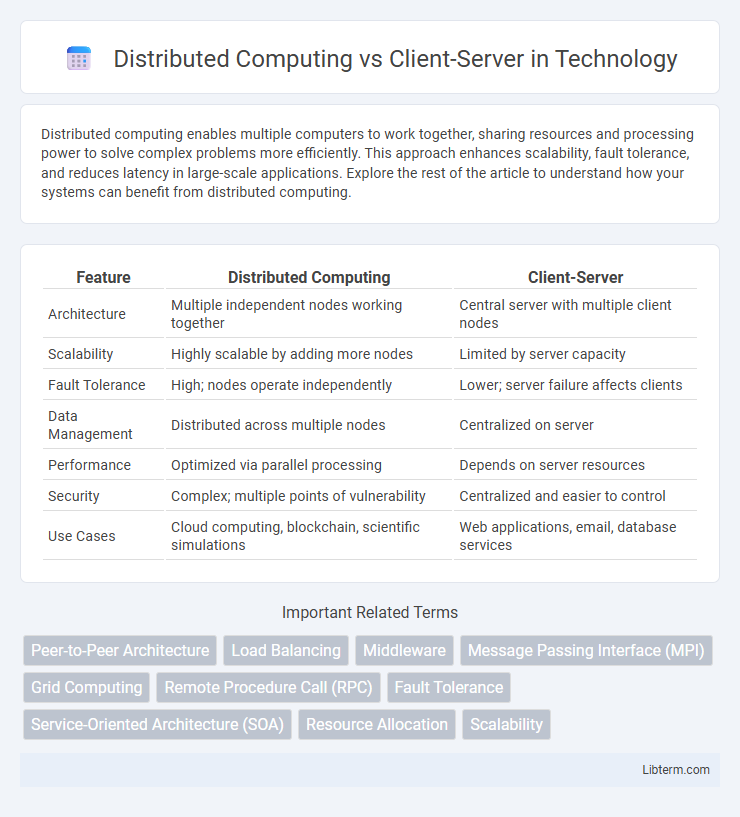Distributed computing enables multiple computers to work together, sharing resources and processing power to solve complex problems more efficiently. This approach enhances scalability, fault tolerance, and reduces latency in large-scale applications. Explore the rest of the article to understand how your systems can benefit from distributed computing.
Table of Comparison
| Feature | Distributed Computing | Client-Server |
|---|---|---|
| Architecture | Multiple independent nodes working together | Central server with multiple client nodes |
| Scalability | Highly scalable by adding more nodes | Limited by server capacity |
| Fault Tolerance | High; nodes operate independently | Lower; server failure affects clients |
| Data Management | Distributed across multiple nodes | Centralized on server |
| Performance | Optimized via parallel processing | Depends on server resources |
| Security | Complex; multiple points of vulnerability | Centralized and easier to control |
| Use Cases | Cloud computing, blockchain, scientific simulations | Web applications, email, database services |
Introduction to Distributed Computing and Client-Server Models
Distributed computing involves multiple interconnected computers working together to perform complex tasks, enhancing scalability, fault tolerance, and resource sharing across a network. The client-server model is a fundamental architecture in distributed computing where clients request services or resources from centralized servers, enabling efficient data management and application deployment. Understanding these models is crucial for designing systems that balance load, optimize performance, and ensure reliability in networked environments.
Core Concepts: What Defines Distributed Computing?
Distributed computing is defined by its architecture where multiple autonomous computers communicate and coordinate their actions by passing messages to achieve a common goal. Unlike client-server models which rely on a centralized server to manage requests, distributed computing emphasizes decentralization, fault tolerance, and resource sharing across nodes. Key concepts include concurrency, scalability, and transparency in resource location, enabling complex computations to be performed efficiently by the networked system.
The Fundamentals of Client-Server Architecture
Client-server architecture organizes computing tasks between servers that host resources and clients that request services, ensuring centralized control and efficient resource management. Distributed computing extends this model by decentralizing processing across multiple interconnected nodes, promoting scalability and fault tolerance. Core to client-server systems is the clear division of roles, protocol-driven communication, and server-based data storage, which collectively optimize performance and security.
Key Differences: Distributed Computing vs Client-Server
Distributed computing involves multiple interconnected nodes collaborating to perform complex tasks, enhancing scalability and fault tolerance, while the client-server model relies on a centralized server providing resources or services to multiple clients. In distributed computing, processes run concurrently on various machines in a network, facilitating resource sharing across diverse systems; whereas client-server architecture typically features distinct roles where clients request and servers respond. Key differences include the level of decentralization, with distributed computing offering greater redundancy and load distribution compared to the more hierarchical, centralized nature of client-server systems.
Scalability: Which Model Performs Better?
Distributed computing offers superior scalability by enabling multiple interconnected nodes to share workloads dynamically, efficiently handling growing data and user demands. Client-server models often face limitations due to centralized server constraints, which can become bottlenecks under high traffic. Scalability in distributed systems is enhanced through load balancing, fault tolerance, and resource pooling, making them more adaptable to large-scale and variable workloads.
Fault Tolerance and Reliability Comparison
Distributed computing systems enhance fault tolerance by distributing workloads across multiple nodes, ensuring system reliability even if individual components fail. Client-server architectures rely heavily on centralized servers, which can become single points of failure, reducing overall reliability unless redundancy or failover mechanisms are implemented. The decentralized nature of distributed computing leads to higher availability and resilience compared to traditional client-server models.
Security Considerations in Both Architectures
Distributed computing environments often face security challenges such as data integrity, authentication, and secure communication across multiple nodes, requiring robust encryption protocols and decentralized access controls. Client-server architectures centralize security management, enabling easier implementation of firewalls, intrusion detection systems, and user authentication but may introduce single points of failure vulnerable to attacks. Both models demand comprehensive security strategies including regular patching, secure credential management, and continuous monitoring to mitigate risks specific to their communication patterns and access control mechanisms.
Real-World Applications and Use Cases
Distributed computing enables large-scale data processing by leveraging multiple interconnected computers, making it ideal for scientific simulations, big data analytics, and blockchain technology. Client-server architecture centralizes resources and services in a server accessed by client devices, commonly used in web applications, online gaming, and email services. Real-world applications demonstrate distributed computing's scalability and fault tolerance, while client-server models excel in controlled environments requiring centralized management and security.
Pros and Cons: Distributed Computing vs Client-Server
Distributed computing offers enhanced scalability and fault tolerance by spreading tasks across multiple nodes, reducing single points of failure. Client-server architecture simplifies management and security by centralizing data processing but may suffer from performance bottlenecks under high demand. While distributed systems improve resource utilization and redundancy, they often require complex synchronization and higher maintenance overhead compared to the more straightforward client-server model.
Choosing the Right Model for Your Project
Distributed computing enhances scalability and fault tolerance by leveraging multiple interconnected nodes to perform tasks, making it ideal for large-scale, resource-intensive applications like data analytics and cloud services. Client-server architecture centralizes control in a single server responding to multiple clients, which is simpler to implement and suitable for smaller, straightforward applications such as web hosting and enterprise intranets. Evaluating project requirements, including scalability, complexity, latency tolerance, and maintenance overhead, guides the choice between distributed computing and client-server models to optimize performance and resource utilization.
Distributed Computing Infographic

 libterm.com
libterm.com